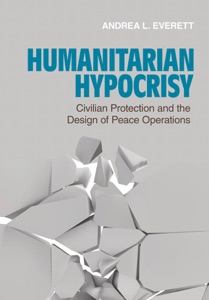Research & Data
Book
Humanitarian hypocrisy: Civilian Protection and the Design of Peace Operations
Since the end of the Cold War, protecting civilians from conflict and atrocities has been a major focus with governments, the UN, and activists and NGOs. Yet peace operations – the main policy instrument for directly shielding civilians from violence – vary widely. Many offer very little protection, and a few are designed to provide it effectively. Often there is a gap between a force’s ambitions to protect civilians and its physical resources for doing so. These missions gesture toward protecting civilians but are not designed to address people’s most pressing security needs. Unfortunately, they can also worsen civilian suffering. The book explores the reasons for this variation, focusing especially on these ambitions-resources gaps. To do so it examines the role of several great power democracies – the U.S., UK, France, and in its own region, Australia – in contributing to peace operations and determining how they are designed. I argue that for these states ambitions-resources gaps represent a form of organized hypocrisy that helps leaders balance competing normative and material pressures to protect civilians while limiting costs and risks. Meanwhile, these compromises lead to disparities between the humanitarian principles leaders proclaim and what their policies are actually designed to accomplish. I expect leaders to promote ambitions-resources gaps when they face strong pressure to protect civilians along with strong reasons to worry about high costs and dangers of intervention. My argument also has implications for the circumstances that promote both more limited and more robust civilian protection efforts. Statistical analysis of extensive original data and in-depth case studies support the argument and fill holes in our understanding of civilian protection, peace operations, and democratic foreign policy.
You can access the online appendix referred to in the book here.
PEER-REVIEWED ARTICLES AND DATA
“Mind the Gap: Civilian Protection and the Politics of Peace Operation Design,” Security Studies, V.26, No.2 (2017):
213-248. DOI: 10.1080/09636412.2017.1280298.
Abstract: Protecting civilians from conflict and atrocities has become a major focus of governments, the UN, and activists. Yet peace operations -- the main policy instrument for directly shielding civilians from violence -- vary widely in how well they are designed to do so. One much-maligned problem is a gap between a force’s ambitions to protect civilians and its physical resources for doing so. Missions plagued by these ambitions-resources gaps gesture toward protecting civilians but are not designed to do so effectively. They can also worsen civilian suffering. This article explores the politics behind these gaps, focusing on the role of powerful states -- especially major Western democracies -- in creating and facilitating them. It argues that ambitions-resources gaps represent a form of organized hypocrisy that helps political leaders balance competing normative and material pressures to protect civilians while limiting costs and risks. Case studies of France’s Operation Turquoise in Rwanda and US support for the African Union Mission in Sudan (AMIS) in Darfur support the argument.
You can access the article here.
“Complex Humanitarian Emergencies: A New Post-Cold War Dataset”
Conflict Management and Peace Science, V.33 No.3 (2016). DOI: 10.1177/0738894215581318.
Abstract: This article introduces an original dataset of post-Cold War complex humanitarian emergencies. The dataset identifies recent instances of war, atrocity crimes, one-sided violence and communal conflict with the most disruptive consequences for civilians. In doing so, it complements a growing body of research and data on civilians’ experiences in war and other forms of violent conflict. While much recent research examines the causes of intentional violence against civilians, this data is likely to be especially useful for investigating questions that require comparison between conflicts on the basis of their human consequences, whether intended or not. Notably, this includes research into the politics of humanitarian action. The article lays out the motivation behind the project, discusses the criteria for identifying complex emergencies and the data-collection process, provides a brief overview of the data and offers some ideas for possible applications. As an example of how the data might be employed, it uses them to demonstrate the importance of humanitarian needs over US political interests in the allocation of US disaster assistance during conflict situations.
You can download the article here.
Dataset
Post-Cold War Complex Humanitarian Emergencies
Stata replication files for results from the article
Dataset for CMPS 2016 Analysis
Online Appendix
Parts I & II: List of Variables and Operational Guidelines
Part III: Complex Emergency Coding Notes
WORK IN PROGRESS
“Savvy Samaritans: How Donors Adjust Aid in Response to Armed Conflict,” with Daniel Tirone
(under review - please contact me for a copy)
“Patterns of aid-giving after natural disasters” (with Daniel Tirone)
“Understanding Humanitarian Sentiment: Comparing Individual Responses to Conflict and Natural Disasters”
Cornell University Press, 2017

